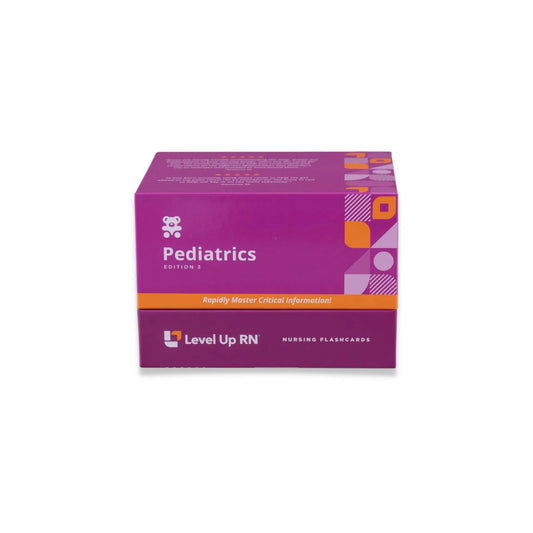Peds, part 24: Cardiovascular Disorders - Congenital Heart Defects - COA, Aortic Stenosis, Pulmonary Stenosis, TGA, TAPVC, Truncus Arteriosus, HLHS
Updated: Cathy ParkesCongenital heart defects that cause obstruction of blood flow, including: coarctation of aorta (COA), aortic stenosis and pulmonary stenosis. Congenital heart defects that cause mixed blood flow, including: transposition of the great arteries (TGA), total anomalous pulmonary venous connection (TAPVC), truncus arteriosus, and hypoplastic left heart syndrome (HLHS). In addition to explaining each disorder, the signs/symptoms and treatment of the defects.
Full Transcript: Peds, part 24: Cardiovascular Disorders - Congenital Heart Defects - COA, Aortic Stenosis, Pulmonary Stenosis, TGA, TAPVC, Truncus Arteriosus, HLHS
Full Transcript: Peds, part 24: Cardiovascular Disorders - Congenital Heart Defects - COA, Aortic Stenosis, Pulmonary Stenosis, TGA, TAPVC, Truncus Arteriosus, HLHS
Hi, I'm Cathy with Level Up RN. In this video, we are going to talk about congenital heart defects that obstruct blood flow and result in mixed blood flow. At the end of the video, I'm going to give you guys a little quiz to test your knowledge of some of the key points I'll be covering in this video, so definitely stay tuned for that. And if you have our Level Up RN pediatric nursing flashcards, pull those out so you can follow along with me. Congenital heart defects that cause obstructed blood flow include coarctation of the aorta, aortic stenosis, and pulmonary stenosis.With coarctation of the aorta, we have a narrowing of the aorta, which is the main artery of the heart that supplies blood to the body. This narrowing occurs after blood is supplied to the upper extremities. So the upper extremities are getting plenty of blood, but the lower extremities? Not so much. So signs and symptoms of this disorder include upper extremity hypertension and bounding pulses - because of all this blood - but then we will have poor lower extremity perfusion. So the lower extremities will have weak pulses and the skin may be cool, and you may see pallor. In terms of treatment, we can use a balloon angioplasty or stents to try to open up that narrowed section of the aorta. We can also surgically remove that narrowed section of the aorta. And then we also need to manage the patient's hypertension with blood pressure medications.
All right, next we have aortic stenosis. This is where we have narrowing of the aortic valve, which separates the left ventricle from the aorta, and this decreases blood flow to the whole body. So this is different than coarctation of the aorta, where the upper body was getting lots of blood. With this condition, the whole body is not getting sufficient blood. So we have signs and symptoms such as hypotension and decreased pulses, as well as tachycardia, because the heart is trying to compensate for that hypotension by increasing the heart rate. In addition, the child may have poor feeding and exercise intolerance. Treatment of this condition includes a balloon dilation or valvotomy to try to open up that narrowed valve. And then lastly, we have pulmonary stenosis, which is narrowing of the pulmonary valve, which separates the right ventricle from the pulmonary artery, and it obstructs blood flow to the lungs. Signs and symptoms include a systolic ejection murmur - that's a key symptom with this condition - as well as cyanosis, cardiomegaly - so enlargement of the heart - and heart failure. Treatment options include a balloon dilation or a valvotomy, again to try to open up that narrowed valve.
Next, we have our congenital heart defects that result in mixed blood flow. This includes transposition of the great arteries, or TGA, as well as total anomalous pulmonary venous connection. It's a mouthful, I know. We also have truncus arteriosus, as well as hypoplastic left-heart syndrome. So let's go through these one by one. First of all, we have TGA or transposition of the great arteries. This is where the aorta and pulmonary artery connections to the heart are reversed. So what does this mean? Well, normally our blood flow goes from the right atrium to the right ventricle to the lungs, and then to the left atrium, left ventricle, and then the rest of the body. But with our connections reversed, deoxygenated blood in the right ventricle is being pumped out to the body. In addition, after blood is oxygenated in the lungs and goes to the left side of the heart, so the left atrium and the left ventricle, it's being pumped right back into the lungs. So obviously this is a problem, and survival of this defect requires that the child have a patent ductus arteriosus or a septal defect, which allows for some mixing of blood so that at least there's some amount of oxygenation of the blood.
So in terms of signs and symptoms of this condition, it will cause heart failure, shortness of breath, cardiomegaly, so enlargement of the heart, as well as cyanosis, hypoxia, murmurs, fatigue, and poor growth. Treatment will include the use of prostaglandins to help keep that PDA, the patent ductus arteriosus, open to allow for mixing up blood until we can get the child to surgery. Surgery is usually performed within the first week of life to reverse those connections and correct the defect. All right, next we have TAPVC, which again was total anomalous pulmonary venous connection. This is where the pulmonary veins are connected to the right side of the heart instead of the left atrium. And this causes a problem because oxygenated blood is being pumped right back to the lungs, which is not what we need. So this defect requires a ASD, so atrial septal defect, in order for the patient to survive this congenital heart defect. So signs and symptoms include cyanosis, dyspnea, as well as poor feeding. Treatment includes a surgical repair to connect the pulmonary veins to the left atrium versus to the right side of the heart.
Next, we have truncus arteriosus. With this defect, instead of a separate pulmonary artery and aorta, we have a single vessel or trunk that is coming off the heart and then branches off to the lungs and to the rest of the body. Along with this defect, the patient will have a VSD, so ventricular septal defect. And this causes the mixing of blood and symptoms such as heart failure, murmurs, cyanosis, as well as poor feeding. Treatment of this defect includes surgical repair within the first few months of life. And then finally, we have hypoplastic left-heart syndrome. This is where the left side of the heart, along with the associated structures there on the left side of the heart, are underdeveloped. So normally the left side of the heart is responsible for getting oxygenated blood back from the lungs and pumping it into systemic circulation. But with this condition, it's unable to do its job effectively because of the fact that it's underdeveloped. So with this defect, the patient will also have a patent ductus arteriosus, as well as an atrial septal defect. So when oxygenated blood comes from the lungs into the left atria, it will flow from the left atrium through that atrial septal defect into the right atrium and then down to the right ventricle. And then the right ventricle is having to pick up the slack for the left side of the heart so that right ventricle will pump blood to the lungs and into systemic circulation through that patent ductus arteriosus. So this condition can cause signs and symptoms such as cyanosis, heart failure, cold extremities, as well as lethargy. So treatment includes the administration of prostaglandins to keep that patent ductus arteriosus open until we can perform surgery. And surgery is done in three different stages, which include the Norwood procedure, Glenn Shunt, and Fontan procedure.
All right, it's quiz time. Are you guys ready? I have three questions for you. First question. What type of murmur is heard with pulmonary stenosis? The answer is a systolic ejection murmur. Question number two, what congenital heart defect is characterized by hypertension and bounding pulses in the upper extremities and weak pulses in the lower extremities? The answer is coarctation of the aorta. Question number three, what congenital heart defect causes the aorta and pulmonary artery connections to the heart to be reversed? The answer is transposition of the great arteries. All right. That's it. I hope my explanations of these heart defects was helpful. If so, be sure to like this video. Leave me a comment. Take care and good luck with studying. Treatment includes surgical repair within the first of [inaudible]. So let's try that again. Next, we have truncus arteriosus, which is a defect that causes a single vessel or trunk to come off of the heart as opposed to separate pulmonary artery and aorta. So the single trunk.


